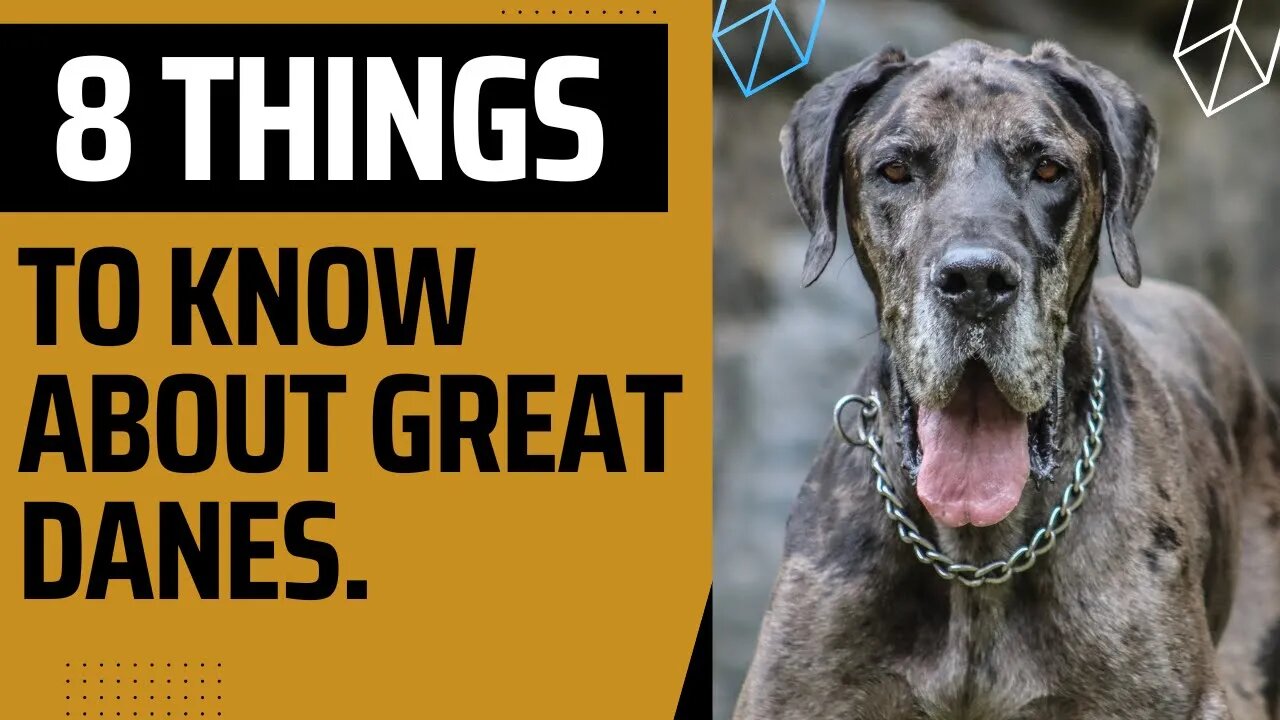Premium Only Content

8 Things To Know About Great Danes.
Today I will talk about such a wonderful dog breed as Great Dane.
Great Danes were first bred as boar-hunting dogs in the 1800s in Europe.
They are known as the “Apollo of dogs” due to their stately grace.
Like other large breeds, they can be susceptible to health issues.
They’re certainly great, but did you know they’re not Danish?
Dogs resembling Great Danes appear as far back as ancient Egyptian carvings,
but the modern Great Dane was actually bred in Germany in the 1800s as a boar-hunting beast.
Today, these gentle giants make beloved family pets,
and are often described as “the Apollo of dogs”,
thanks to their grace, courage, stature, and beauty.
Here’s everything else you need to know about these colossal canines:
#1. Great Danes are the tallest dogs in the world.
A male Great Dane can reach up to 32 inches at the shoulder and weigh a massive 175 pounds. Females are slightly smaller,
at up to 30 inches and 140 pounds — and both males and females can tower over many humans when they stand on their hind legs.
Despite their size, Great Danes are elegant and even regal in their gait and disposition.
#2. Despite their daunting size, Danes are highly affectionate and social.
These pups love love.
They need lots of affection and socialization with people and other animals, making them great family pets.
Thanks to their sweet, gentle, patient dispositions, Danes are even great with kids — though like all dogs,
they should never be left alone with young children,
and they’ll need to be taught not to play as rough as they would with a puppy.
#3. Daily exercise is a must for this big breed.
You won’t need to run a daily marathon with your Great Dane, but they will need activity.
Two brisk walks of decent length should do it, though remember that puppies have more energy and should be exercised accordingly.
As adults, Great Danes are happy jogging companions, but it’s important to wait until they’re at least two years old,
as running before them can damage their bones.
#4. Great Danes tend to follow their noses.
These dogs were bred to hunt boar, and if they get a scent, they’ll want to follow it.
Walks should be on-leash, and at home, and any yard will need to be securely fenced.
#5. Proper training is essential for Great Danes.
With dogs this big and powerful, it’s important that they obey commands and are properly socialized.
Luckily, Danes are mostly friendly and eager to please, making training a pleasure (though beware the odd stubborn streak).
Buying from a reputable breeder also ensures good socialization in the crucial early months of the dog’s life.
#6. These outsize athletes love dog sports.
As strong, intelligent working dogs, Great Danes are wonderful competitors in a variety of dog sports,
including Agility, Obedience, Tracking, weight pulls, and Flyball.
#7. Big breeds have big needs.
A Great Dane can cost a lot more to feed than a small dog, in addition to incurring higher-than-average medical fees and wear-and-tear to your home and car.
If you’re bringing a Great Dane into your life, be aware that owning one will not come cheap.
#8. Great Danes have a relatively low life expectancy.
These gentle giants sadly tend to live just seven to ten years — though they will certainly fill those years with several lifetimes’ worth of love.
So, now you know a little more about Great Danes.
We thank you for watching this video and don't forget to subscribe to our channel for more interesting animal facts.
-
 1:08:45
1:08:45
DeVory Darkins
21 hours agoLetitia James drops frantic speech after pleading not guilty as Canada gets NIGHTMARE NEWS
92.1K46 -
 1:25:16
1:25:16
efenigson
2 days agoDigital Money or Digital Prison? - Nick Anthony | You're The Voice - LIVE from Lugano PlanB Forum!
19.8K3 -
 13:26
13:26
Cash Jordan
16 hours ago“PORTLAND MOB” Storms ICE HQ… ‘COMBAT’ Troops Respond With EXTREME FORCE
20.2K48 -
 16:00
16:00
Demons Row
14 hours ago $6.57 earnedBIKERS OF FLORIDA 💀🏍️ Outlaws, Warlocks, Mongols & the Wild South
12.5K10 -
 22:01
22:01
Jasmin Laine
17 hours agoTrump’s BRUTAL WARNING Leaves Canada Speechless—America STUNNED
18.6K56 -
 11:42
11:42
China Uncensored
18 hours agoThe Chinese Military Turns Its Gun on Xi Jinping
13.4K28 -
 2:36
2:36
The Official Steve Harvey
18 hours ago $2.60 earnedThis Is Bigger Than Comedy — It’s About Saving Young Men
11.1K3 -
 8:09
8:09
Hollywood Exposed
20 hours agoMatthew McConaughey EXPOSES The Real Reason He Left Hollywood
19.5K13 -
 29:38
29:38
Stephan Livera
2 days ago $6.59 earnedDay 2 - Stephan Livera hosts Plan B Podcast in Lugano
15.7K2 -
 1:01:47
1:01:47
vivafrei
19 hours agoLive from Lugano Plan B in Switzerland w/ Efrat Fenigson and Prince Filip Karađorđević!
61.2K7